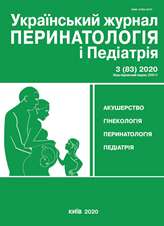Indicators of humoral immunity of patients with neonatal sepsis under different conditions of environmental pollution of parents' places of residence
DOI:
https://doi.org/10.15574/PP.2020.83.66Keywords:
neonatal sepsis, pollution, immunoglobulinsAbstract
The aim is to determine the indicators of humoral immunity of patients with neonatal sepsis under different conditions of environmental pollution of their parents' places of residence.
Materials and methods. 260 patients with neonatal sepsis born to parents who lived in different environmental conditions were examined. An environmental risk factor (CER) was proposed as a group-forming feature of a comprehensive assessment of the long+term load of anthropogenic air, water and soil pollution in the regions of the region on the body of parents of newborns, taking into account the environmental situation in regional centers.
Results. The level of IgA in the serum of patients with neonatal sepsis in group I was 0.82±0.11 g/l against 1.54±0.23 g/l (p<0.05) in group II, the level of IgG in children I groups — 4.27±0.45 g/l against 6.67±0.77 g/l (p<0.05) of group II. The decrease in IgM content had no significant differences, but there was a tendency to reduce its level in children of group I.
Conclusions. The constant residence of parents in areas with a high risk of adverse effects of these environmental factors on their body (ERF<2.0) contributed to a decrease in the level of immunoglobulins A, M, G in the serum of patients with neonatal sepsis, compared with newborns whose parents lived in areas with a low risk of adverse effects (ERF<2.0), and were more likely to have severe neonatal sepsis.
The research was carried out in accordance with the principles of the Helsinki Declaration. The study protocol was approved by the Local Ethics Committee of these Institutes. The informed consent of the patient was obtained for conducting the studies.
References
Anderson–Berry AL, Bellig LL, Ohning BL, Rosenkrantz T et al. (2015). Neonatal Sepsis. Medscape Video NEW Clinical. Cited 2017 Sept 19. URL: http://emedicine.medscape.com/article/978352-overview.
Fazzo L, Minichilli F, Santoro M, Ceccarini A et al. (2017, Oct). Hazardous waste and health impact: a systematic review of the scientific literature. Environmental health. 16: 107. https://doi.org/10.1186/s12940-017-0311-8; PMid:29020961 PMCid:PMC5637250
Fleischmann-Struzek C, Goldfarb DM, Schlattmann P, Schlapbach LJ, Reinhart K, Kissoon N. (2018, Mar). The global burden of paediatric and neonatal sepsis: a systematic review. Lancet Respir Med Lancet Respir Med. 6 (3): 223-230. https://doi.org/10.1016/S2213-2600(18)30063-8
Genowska A, Jamiolkowski J, Szafraniec K, Stepaniak U, Szpak A, Pajak A. (2015). Environmental and socio-economic determinants of infant mortality in Poland: an ecological study. Environmental health. 14: 61. https://doi.org/10.1186/s12940-015-0048-1; PMid:26195213 PMCid:PMC4508882
Giovannini A, Rivezzi G, Carideo P, Ceci R, Diletti G, Ippoliti C et al. (2014). Dioxins levels in breast milk of women living in Caserta and Naples: assessment of environmental risk factors. Chemosphere. 94: 76-84. https://doi.org/10.1016/j.chemosphere.2013.09.017; PMid:24120012
Hotchkiss RS, Monneret G, Payen D. (2013). Immunosuppression in sepsis: novel understanding of the disorder and a new therapeutic approach. Lancet Infect Dis. 13 (3): 260-268. https://doi.org/10.1016/S1473-3099(13)70001-X
Kamalakannan SK. (2018). Neonatal Sepsis Past to Present. Biomed J Sci, Tech Res. 3 (3): 1-6. URL: https://biomedres.us/pdfs/BJSTR.MS.ID.000909.pdf. https://doi.org/10.26717/BJSTR.2018.03.000909
Kihal-Talantikite W, Zmirou-Navier D, Padilla C, Deguen S. (2017, May). Systematic literature review of reproductive outcome associated with residential proximity to polluted sites. International journal of health geographics. 16: 20. https://doi.org/10.1186/s12942-017-0091-y; PMid:28558782 PMCid:PMC5450119
Kouassi B, Horo K, Gode C, Ahui B, Kouassi MN, Koffi N et al. (2015). Clinical manifestations in patients exposed to an environmental toxic accident (Abidjan, Ivory Coast 2006). Rev Mal Respir. 32 (1): 38-47. https://doi.org/10.1016/j.rmr.2014.01.015; PMid:25618203
Schlapbach LJ. (2017). Time for Sepsis-3 in Children? Pediatr Crit Care Med. 18 (8): 805-806. https://doi.org/10.1097/PCC.0000000000001203; PMid:28796706
Shane AL, Stoll BJ. (2014). Neonatal sepsis: progress towards improved outcomes. J Infect. 68 (1): 24-32. https://doi.org/10.1016/j.jinf.2013.09.011; PMid:24140138
Singer M, Deutschman CS, Seymour CW, Shankar-Hari M, Annane D, Bauer M et al. (2016). The Third International Consensus Definitions for Sepsis and Septic Shock (Sepsis-3). JAMA. 315 (8): 801-810. https://doi.org/10.1001/jama.2016.0287; PMid:26903338 PMCid:PMC4968574
Statystychnyj shhorichnyk Chernivecjkoji oblasti za 2017 rik. (2018). Za red. T.Gh Sarchynskoi. Chernivci: 543.
Statystychnyj shhorichnyk Khmeljnycjkoji oblasti za 2017 rik. (2018). Za red. LO Khamskoi. Khmeljnycjkyj: 514.
World Health Organization. (2016). Waste and human health: Evidence and needs. WHO Meeting Report: 5–6 November 2015. Bonn, Germany. Copenhagen: WHO Regional Office for Europe. URL: http://www.euro.who.int/__data/assets/pdf_file/0003/317226/Waste-human-health-Evidence-needs-mtg-report.pdf?ua=1.
World Health Organization. (2018). WHO Sepsis Technical Expert Meeting. Switzerland: 36. URL: https://www.who.int/servicedeliverysafety/areas/sepsis_meeting-report-2018.pdf.
Downloads
Published
Issue
Section
License
The policy of the Journal “Ukrainian Journal of Perinatology and Pediatrics” is compatible with the vast majority of funders' of open access and self-archiving policies. The journal provides immediate open access route being convinced that everyone – not only scientists - can benefit from research results, and publishes articles exclusively under open access distribution, with a Creative Commons Attribution-Noncommercial 4.0 international license(СС BY-NC).
Authors transfer the copyright to the Journal “MODERN PEDIATRICS. UKRAINE” when the manuscript is accepted for publication. Authors declare that this manuscript has not been published nor is under simultaneous consideration for publication elsewhere. After publication, the articles become freely available on-line to the public.
Readers have the right to use, distribute, and reproduce articles in any medium, provided the articles and the journal are properly cited.
The use of published materials for commercial purposes is strongly prohibited.

